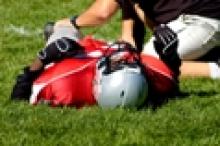
Bukal v. Illinois High School Ass'n, the much-publicized Illinois high school concussion lawsuit, appears to be the next step in Chicago attorney Joe Siprut's campaign to use class action settlements to implement changes to high school and college football concussion policies.
Bukal makes little pretense to being anything but the opening gambit in a legal chess game designed to get the IHSA to settle. Indeed, the 52-page complaint - most of which is spent recounting the history of concussion management guidelines issued by national and international organizations since the beginning of the 21st century - dispenses with the threat of monetary damages, and gets right down to business, demanding that the IHSA require pre-season baseline testing of football players (which, so far, has not been mandated by any state), develop a program to track concussions (which a number of states' concussion laws require), require medical personnel, such as certified athletic trainers, with concussion expertise at all games and available for practices, and establish a fund to pay for the medical monitoring of past and present high school football players from 2002 to the present.
If all this sounds familiar, well, that's because it is. Siprut's Illinois high school lawsuit asks for the same relief requested in the settlement he proposed in Arrington v. NCAA, his college concussion lawsuit, which was consolidated with another concussion suit and ultimately went forward as In Re National Collegiate Athletic Association Student Athlete Concussion Injury Litigation in the Northern District of Illinois. Siprut appears to have liked the proposed settlement in his college concussion lawsuit so much that he simply asked for the exact same relief in his Illinois high school lawsuit.
Bad deal for athletes?
Siprut's proposals may not hold up, however. The reason is that, on December 17, 2014, District Court Judge John Lee rejected as insufficient the settlement Siprut reached with the NCAA, just as many legal experts predicted he would. The reason was that, while a good deal for college football players and wrestlers, it didn't adequately protect the interests of the numerous college athletes playing other sports who also sustain concussions. The $70 million earmarked for concussion monitoring in the proposed settlement sounds impressive until one realizes that it didn't factor in non-contact sport athletes who may wish or need to avail themselves of the monitoring. Indeed, Judge Lee specifically noted college baseball catchers and water polo players as examples of non-contact sport athletes who may need monitoring. And that's just the tip of the iceberg: wait until a college cheerleader wants post-concussion monitoring .
Siprut's settlement proposal would also prevent class members (at least those who don't opt out) from suing for damages in the future. Considering the size of the class, the protection the NCAA would have gotten from future damage suits, and the failure to provide monitoring for non-contact sport athletes, it's safe to say that the NCAA would have gotten a really good deal out of its proposed settlement with Siprut. And, in fairness to Siprut, it's hard to say that he cut a bad deal. His true interest was football players, and the settlement he proposed would have protected them. However, because he represented a class that included, not just football players, but also the numerous other athletes who might suffer a concussion and need testing, his settlement, had it been accepted by the Court, offered very little to benefit those other athletes.
Siprut didn't ask for such a broad duty, but in class actions one's duty in representing the entire class sometimes transcends one's expectations. Siprut wasn't able to transcend his expectations because his focus was on football. He either didn't think of or didn't know of the rich complexities of college sports. This lack of either knowledge or concern proved fatal to his college proposed settlement, at least for now.
Wrong choice of defendant?
In my view, Siprut has already gotten off on the wrong foot in his high school litigation. His first mistake was in his choice of defendants. Siprut has made it clear that he actually views his Illinois high school suit as an efficient way to get state high school associations to implement the policies that match his vision of safety: in short, it is just the first of a series of 51 separate lawsuits. That he sued just one high school athletic association, of course, begs the question why Siprut simply didn't sue the National Federation of State High School Associations (NFHS)?
Siprut's answer was puzzling, to say the least. The reason he didn't sue the NFHS is because, purportedly, it doesn't exert the same control over high school sports that the NCAA exerts over college sports. As a high school sports administrator, I view the choice of defendant as a clear indication that Siprut has a fundamental misunderstanding of the way high school sports are run in this country.
Siprut is absolutely correct that the NFHS does not exert the same degree of administrative control over high school sports that the NCAA exerts over college sports. However, he completely ignores the fact that player safety at the high school level is not entirely a matter of administrative control, it's also a matter of policy- and rule-setting. The NFHS sets the national high school playing rules, and over the last eight years, it has made it quite clear that it can and will change the rules that govern high school sports to protect the safety of athletes.
To give just one example, the NFHS has changed the rules for high school wrestling in order to require all wrestlers to engage in a weight management program, hydration testing, and body composition testing to set the maximum weight a wrestler can safely lose (or, in the parlance, "cut") each week. The program prevents wrestlers from unsafely cutting weight, and has most certainly reduced deaths and unhealthy eating practices in wrestling.
The NFHS has also used its rule-making authority to set concussion removal and return to play policies in all sports. Granted, many state legislatures and individual high school state governing bodies have gone further, but it is clear that the NFHS has no problem using playing rules to set health prerequisites to participation and standards for removal from play in the case of suspected head injury.
Clearly, if an attorney was looking for the most efficient way to effect a nationwide change, he would sue the NFHS. It's unfathomable that Siprut didn't do this.



